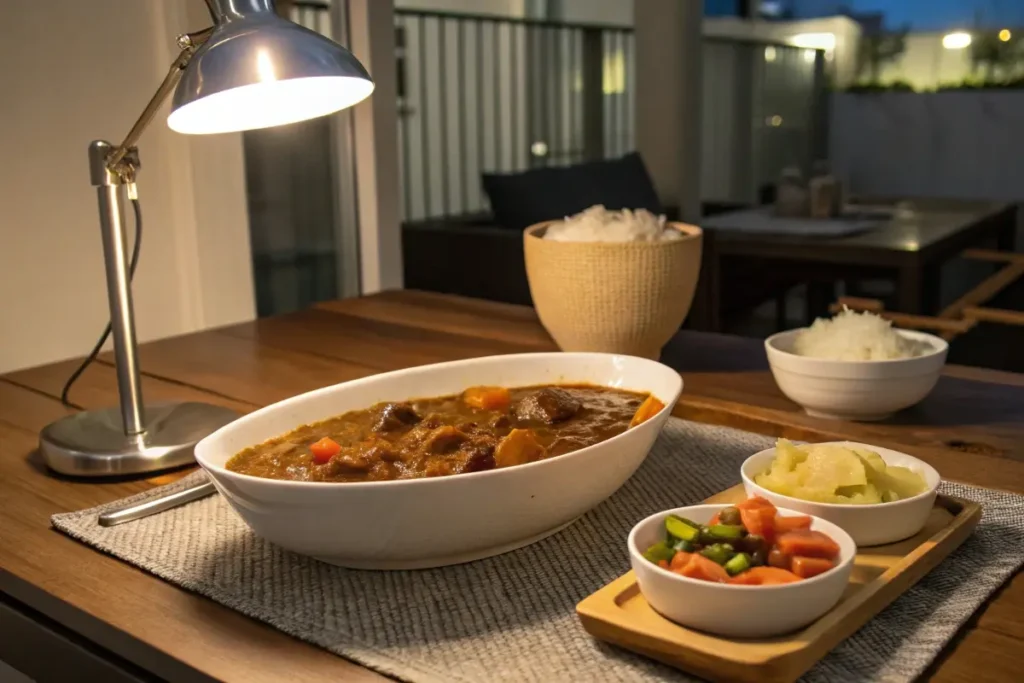Japanese beef curry is a heartwarming dish that encapsulates the essence of comfort food with an elegant twist. Within your very first bite, you’ll notice how it differs from other curries around the world: it’s less fiery hot, subtly sweet, and carried by a velvety sauce that clings to each piece of meat and vegetable. If you’ve been searching for a japanese beef curry recipe that delivers on both taste and authenticity, you’re in the right place.
In Japan, beef curry and rice is akin to a national favorite—served in homes, restaurants, and even school cafeterias. The question arises: What kind of beef is best for Japanese curry? Generally, well-marbled but affordable cuts like chuck roast or brisket are preferred. In this article, we’ll explore every aspect of cooking Japanese beef curry, from selecting the right ingredients to mastering the slow-cooked technique that yields a melt-in-your-mouth texture. For fans of a slow cooker approach, we’ll also tackle the japanese beef curry slow cooker method to ensure a fuss-free cooking experience. And if you’re curious about What makes Japanese curry different? we’ll delve into that, too.
Before we dive in, feel free to check out our other savory dishes like Japanese Curry Recipe One Piece for more insights into the diverse range of curries in Japan. Let’s begin our journey into the fragrant, hearty world of Japanese beef curry.
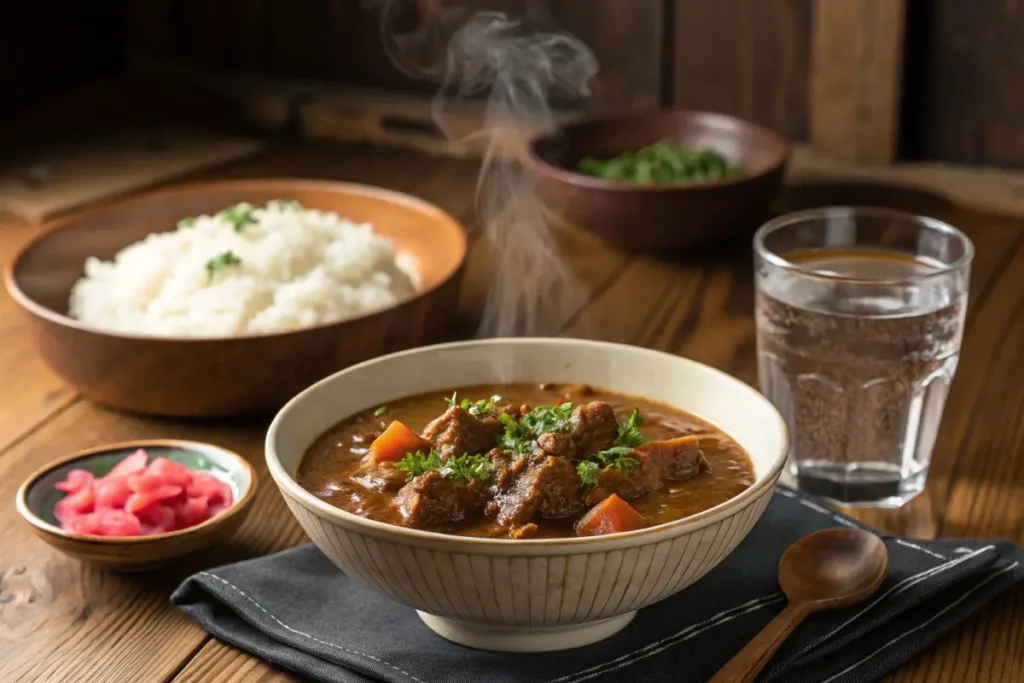
Want to try Japanese beef curry at home? Here are some essentials you can find on Amazon to make the process easier:
- Japanese Curry Roux Blocks – authentic flavor, quick and convenient
- Cast-Iron Dutch Oven – ideal for slow simmering beef curry
- Short-Grain Japanese Rice – the perfect pairing for curry rice
The Core Elements of Japanese Beef Curry
A japanese beef curry recipe stands out for its luxurious sauce and balanced spice profile. While Indian curries can be quite spicy and Thai curries often feature chili-laden coconut bases, Japanese curries prioritize mellow warmth and rich depth. Let’s break down what differentiates Japanese curry from its counterparts.
1. Roux-Based Curry
Japanese curry sauce frequently relies on a roux—commonly found in convenient curry blocks sold at supermarkets. This roux blends flour, fats, and spices into a thick paste, which dissolves in simmering stew. If you prefer cooking from scratch, you can make your own roux by browning butter and flour, then mixing in curry powder and mild chili flakes.
- Secret Ingredient: Some swear by adding chocolate, coffee, or apples to amplify sweetness and acidity. This is often the secret ingredient for curry in Japanese kitchens.
Shortcut Option: Many Japanese households rely on Japanese Curry Roux Blocks for convenience. They dissolve easily and deliver a consistent, authentic flavor every time.
2. Choosing the Beef
What kind of beef is best for Japanese curry? Chuck roast or short rib is often used because of its marbling and robust flavor. If you desire even more tenderness, opt for brisket or stew beef. The goal is for the meat to break down slightly, releasing juices into the sauce.
Cooking Tip: For best results, use a sturdy pot like a Cast-Iron Dutch Oven. It holds heat evenly, allowing the beef to simmer gently until tender.
- Marination: Many home cooks wonder, Do you marinate meat for Japanese curry? Usually, you don’t need an extensive marinade. A quick seasoning with salt, pepper, and a splash of soy sauce can help deepen the flavor without overshadowing the curry’s star elements.
3. Vegetables as a Foundation
Carrots, onions, and potatoes frequently appear in japanese curry recipe beef. Onions add sweetness, carrots bring color, and potatoes supply hearty substance. Some cooks add bell peppers or mushrooms for an earthy twist.
4. Mild and Sweet vs. Hot and Spicy
Contrary to popular belief, Japanese curry can range from mild to fairly spicy. However, the baseline is usually sweet-savory—achieved by cooking down onions and sometimes adding fruit (like grated apple) or sugar. Spice fans can always customize by sprinkling chili powder.
5. Serving and Garnishing
Typically served with short-grain white rice, Japanese curry can also accompany brown rice or noodles.
Traditional Pairing: Japanese curry is almost always served with Authentic Japanese Short-Grain Rice. Its chewy texture perfectly complements the thick curry sauce.
Common garnishes include fukujinzuke (pickled daikon with chili) or rakkyo (pickled shallots) for tangy contrast. The overall meal aims for harmony: tender beef, thick sauce, and pleasantly chewy rice.
Pro Tip: Add a side of Fukujinzuke Pickles for a sweet-tangy crunch that balances the richness of the curry.
If you’re seeking more meaty inspirations, head over to our Minced Beef Japanese Recipe for additional beef-based delights. Ultimately, the essence of Japanese beef curry lies in its silky sauce and balanced flavors, making it a warm, comforting staple year-round.
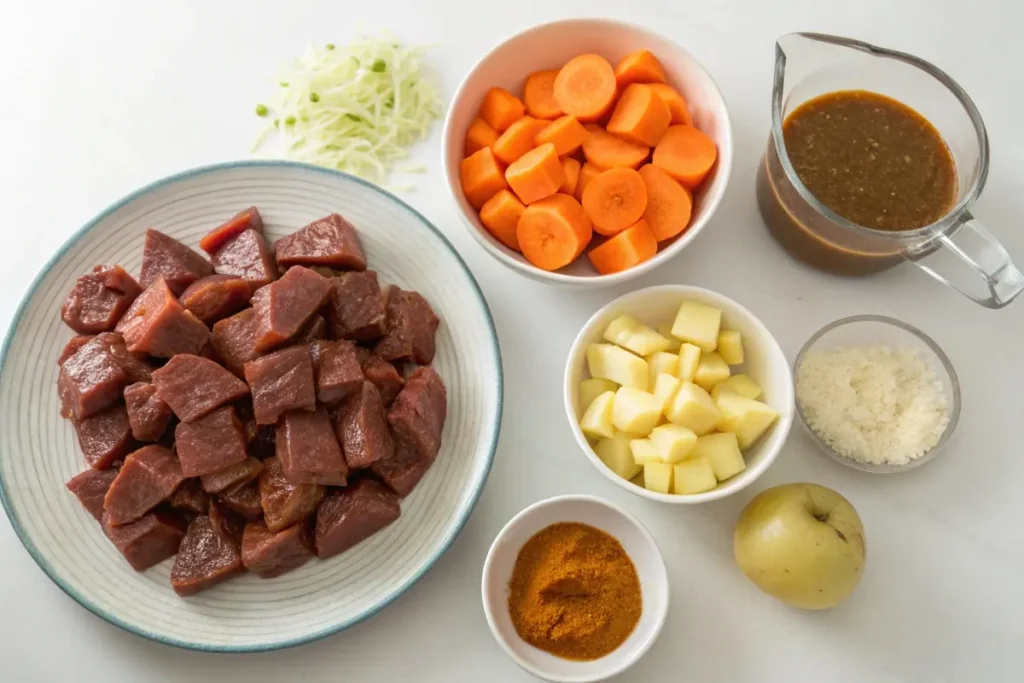
Building Flavor with Key Ingredients and Techniques
While japanese beef curry can look deceptively simple, the depth of flavor arises from a thoughtful blend of spices, seasonings, and slow-cooking techniques. Below, we’ll unpack essential strategies for building complexity in your curry, whether you’re a first-time cook or a seasoned enthusiast.
Homemade Lovers: If you prefer mixing your own spices, try Japanese Curry Powder (S&B). It gives you control over heat and sweetness while keeping the flavor authentic.
1. Browning the Beef
One of the most critical steps is browning the beef before simmering. By searing each piece on high heat, you develop the Maillard reaction—a chemical process that intensifies savory notes. Use a splash of oil in a heavy-bottomed pot, let the beef form a brown crust, and then set it aside.
- Avoid Overcrowding: Brown the beef in batches to prevent steaming. A crowded pan lowers the temperature, compromising flavor.
2. Layering Aromatics
Onions, garlic, and ginger typically form the base of a japanese curry recipe beef. Lightly sauté them until translucent or slightly caramelized. This not only imparts sweetness but also readies the pot for further flavors:
- Garlic & Ginger: Provide aromatic complexity.
- Onions: Natural sweetness, especially if cooked slowly until golden.
3. Slow Cooking for Tenderness
Since Japanese beef curry often features tougher cuts like chuck, a slow-cooking approach ensures fork-tender results. Whether you choose stovetop braising or a slow cook japanese curry method in a crockpot, the key is letting the collagen in the meat break down gradually.
- Stovetop Simmering: Usually takes 1.5 to 2 hours.
- Slow Cooker: Can extend to 5-8 hours on low heat, perfect for a “set it and forget it” meal.
Set & Forget: A reliable Slow Cooker makes it easy to enjoy melt-in-your-mouth Japanese beef curry without constant monitoring.
4. Adding the Curry Roux or Powder
If you’re using store-bought curry blocks, you’ll typically stir them in after the meat and vegetables are tender. For homemade roux, incorporate it gradually, ensuring the sauce thickens evenly. Some chefs also use a dash of katsuobushi (bonito flakes) for an umami boost.
5. Sweeteners and Special Ingredients
What is the secret ingredient for curry? In Japanese cooking, it might be grated apple, honey, or even chocolate. These additions balance the savory elements and contribute a rounded sweetness. Adjust the quantity based on your preference:
- Apples or Pears: Provide natural fructose.
- Honey or Maple Syrup: A little goes a long way.
- Dark Chocolate: Enhances bitterness and depth without overpowering the dish.
6. Consistency and Final Touches
The sauce should be thick yet pourable—enough to coat a spoon without running off. If it’s too thick, add broth or water. If it’s too thin, let it simmer uncovered to reduce. Garnish with a sprinkle of fresh parsley or thinly sliced scallions for contrast.
For an additional perspective on building flavors in a hearty stew, explore our Japanese Curry Recipe One Piece to see how various ingredients interplay in creating a robust curry sauce. These techniques—browning, layering aromatics, slow cooking, and sweetening—remain central whether you’re making a mild curry or a spicier rendition.
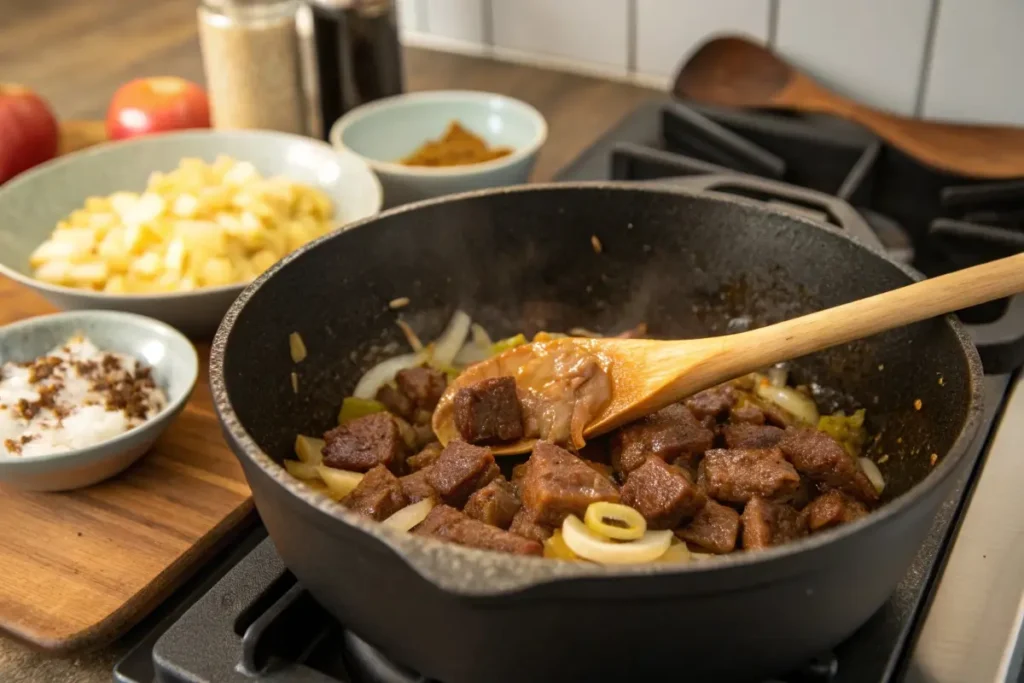
Step-by-Step Recipe: Classic Japanese Beef Curry
Below, you’ll find a detailed japanese beef curry recipe that caters to both stovetop and slow cooker methods. This version balances sweetness, spice, and savory richness, ensuring every spoonful brims with comfort.
Ingredients (Serves 4-6)
- Beef: 1.5 lbs (about 700g) of chuck roast, cut into bite-sized cubes
- Vegetables: 2 onions (sliced), 2 carrots (chopped), 2 medium potatoes (cubed)
- Aromatics: 2 cloves garlic (minced), 1 inch ginger (minced)
- Curry Components:
- Store-bought curry roux blocks (adjust based on spice preference) OR
- Homemade curry powder mix (3 tablespoons) and a simple butter-flour roux (optional)
- Liquid: 3 cups beef stock or water
- Sweetener (Optional): 2 tablespoons grated apple or 1 tablespoon honey
- Oil, Salt, Pepper to taste
- Optional: 1 tablespoon soy sauce for extra umami
Stovetop Instructions
- Sear the Beef: Season beef cubes with salt and pepper. In a large pot over medium-high heat, add oil. Brown the beef in batches until a crust forms. Remove and set aside.
- Sauté Aromatics: In the same pot, lower the heat to medium. Add onions, garlic, and ginger. Cook for 3-5 minutes until onions soften.
- Incorporate Vegetables: Stir in carrots and potatoes. Cook for 2 minutes to lightly brown the edges.
- Combine and Simmer: Return the beef to the pot. Pour in beef stock. Bring to a gentle boil, then reduce heat to a simmer. Skim off any foam that rises.
- Add Curry Roux or Powder: After 45-60 minutes, once the beef is starting to tenderize, stir in the curry roux (or homemade blend with a roux). Let it dissolve fully. Adjust thickness with stock if needed.
- Sweeten and Final Seasoning: Incorporate grated apple or honey. Taste and adjust salt levels. If you crave more depth, add soy sauce or a piece of dark chocolate.
- Cook Until Tender: Continue simmering for another 30 minutes or until beef is fork-tender. The sauce should be thick and fragrant.
- Serve: Ladle curry over steamed rice. Garnish with chopped parsley or pickled ginger for a pop of color.
Slow Cooker Variation
- Brown Beef and Aromatics: Pan-sear the beef and sauté onions as above.
- Transfer to Slow Cooker: Place beef, onions, carrots, potatoes, and any additional seasonings into the slow cooker.
- Add Liquids and Curry Blocks: Pour in stock, add curry roux or powder. Stir briefly.
- Set and Forget: Cook on low for 6-8 hours or on high for 3-4 hours.
- Finishing Touches: Stir in grated apple or honey near the end. Taste and refine with soy sauce if needed.
Pro Tip: Want to simplify the slow cooker method? These tools and ingredients make your Japanese beef curry richer and easier to prepare:
- Reliable Slow Cooker – set it and forget it
- Japanese Curry Powder (S&B) – for authentic homemade flavor
- Japanese Pickles (Fukujinzuke) – classic garnish for curry
Serving Suggestions
- Accompaniments: Typically served with short-grain rice, but brown rice or noodles also work well.
- Condiments: Offer pickled daikon (fukujinzuke) or pickled shallots (rakkyo).
- Leftover Magic: Reheat for lunch or freeze for future quick meals. The flavors intensify over time.
For a creative side dish to accompany your curry, check out our Japanese Radish Recipe for a crunchy, palate-cleansing counterpoint. Now that you have the blueprint, it’s time to bring out your pot or slow cooker and get started on a hearty batch of luscious Japanese beef curry.
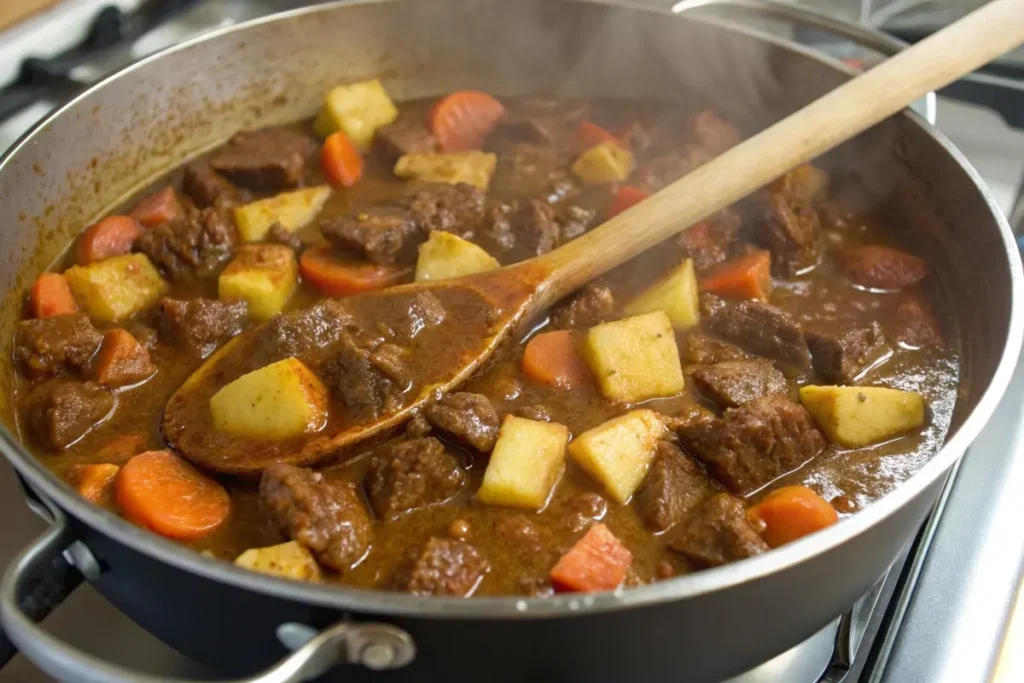
History and Context of Japanese Beef Curry
Though curry is often associated with South Asian cuisine, Japan has embraced and transformed this dish into something uniquely its own. Understanding japanese beef curry recipe traditions involves exploring colonial influences, local adaptations, and the evolution of Japanese palates.
Foreign Origins
Curry first made its way to Japan through British naval influences in the late 19th century. The British had already adopted Indian curries as part of their diet, albeit with milder spice levels and a roux-based sauce. When they introduced curry to Japan, local chefs and home cooks found the dish both exotic and comforting.
Meiji Era Adaptations
During the Meiji era (1868-1912), Japan’s rapid modernization included adopting certain Western dietary habits. With its roux-based approach, curry was quickly adapted to suit local tastes. Japanese chefs toned down the chili heat, emphasizing savory-sweet profiles over intense spiciness. Beef, once a luxury item banned for centuries due to religious and cultural reasons, was newly acceptable as Japan opened up to global influences.
Spread Through the Military and Schools
One significant driver of curry’s popularity was Japan’s navy, which integrated curry rice into weekly meal plans to prevent beriberi, a nutritional deficiency. This tradition trickled down to public schools, and eventually, kids grew up associating curry with nourishing comfort food. Over time, the dish gained mainstream acceptance and became a staple in households nationwide.
Commercial Curry Blocks
In the mid-20th century, manufacturers started producing curry roux blocks—pre-made blends of flour, fats, and seasonings. This convenience factor propelled the dish’s popularity further. Housewives, short on time, could stir a curry block into simmering beef or chicken with vegetables and achieve consistent, delicious results.
Modern Popularity
Today, japanese beef curry stands alongside ramen and sushi as one of Japan’s iconic dishes, bridging tradition with everyday convenience. Contemporary chefs experiment with bold twists—spicier versions, chocolate or coffee enhancements, or even premium wagyu cuts. Restaurants serve it in varying spice levels, and home cooks commonly produce big batches to feed families for multiple days.
For a deeper look at how other beloved Japanese dishes came into being, consider our Japanese Steak Recipe for an overview of how Western influences blended with local cooking methods. Curry’s journey from British import to Japanese staple is a fascinating example of culinary cross-pollination, culminating in a dish that feels entirely, and comfortingly, at home in Japan.
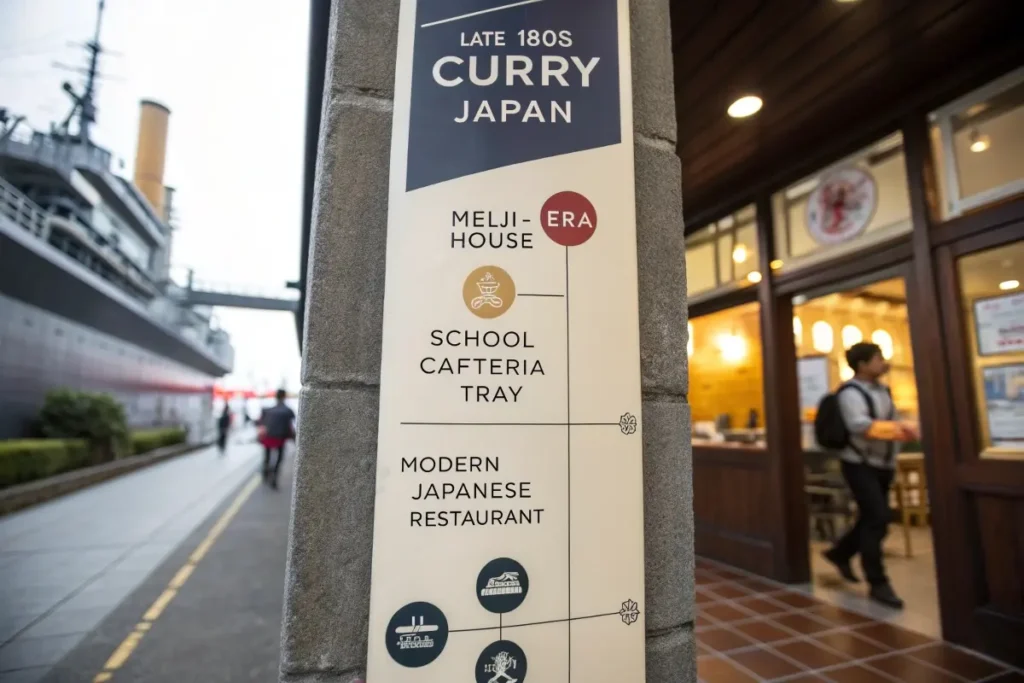
Practical Examples/Use Cases
Japanese beef curry isn’t just a hearty dinner option—its flexibility makes it suited to various situations, from busy weeknights to potluck gatherings. Below are some practical scenarios to inspire your culinary creativity.
1. Weeknight Family Dinner
- Scenario: You want a comforting meal that doesn’t require constant attention.
- Approach: Use the stovetop or try a japanese beef curry slow cooker method. Brown your beef in the morning, then throw everything into the slow cooker before work. When you return, you’ll have a aromatic pot of curry ready to serve over hot rice.
- Benefit: Minimizes prep time while delivering a meal that kids and adults both adore.
2. Meal Prep for the Week
- Scenario: You’re planning lunches or quick reheatable dinners.
- Approach: Cook a big batch of curry on Sunday. Divide it into individual containers with rice. Store in the fridge or freezer.
- Benefit: Curry flavors often deepen with time, making leftovers even tastier.
3. Potluck Star
- Scenario: You’ve been invited to a gathering and need a dish that travels well.
- Approach: Prepare curry in a large pot or even an electric cooker. Warm it just before serving.
- Benefit: The thick sauce and tender beef remain palatable even if it cools slightly. Provide crusty bread or rice on the side.
4. Special Occasions
- Scenario: You’re hosting a family reunion or festive holiday.
- Approach: Step up your game with premium cuts of beef like wagyu or short ribs. Use homemade curry roux for a gourmet flair.
- Benefit: The celebratory version feels luxurious yet familiar, satisfying guests seeking something special.
For a similarly comforting dish that suits multiple meal plans, see our Japanese Chicken Fried Rice Recipe for a quick side or main. From large gatherings to solo dinners, Japanese beef curry is a culinary workhorse that adapts easily to your schedule and portion needs.
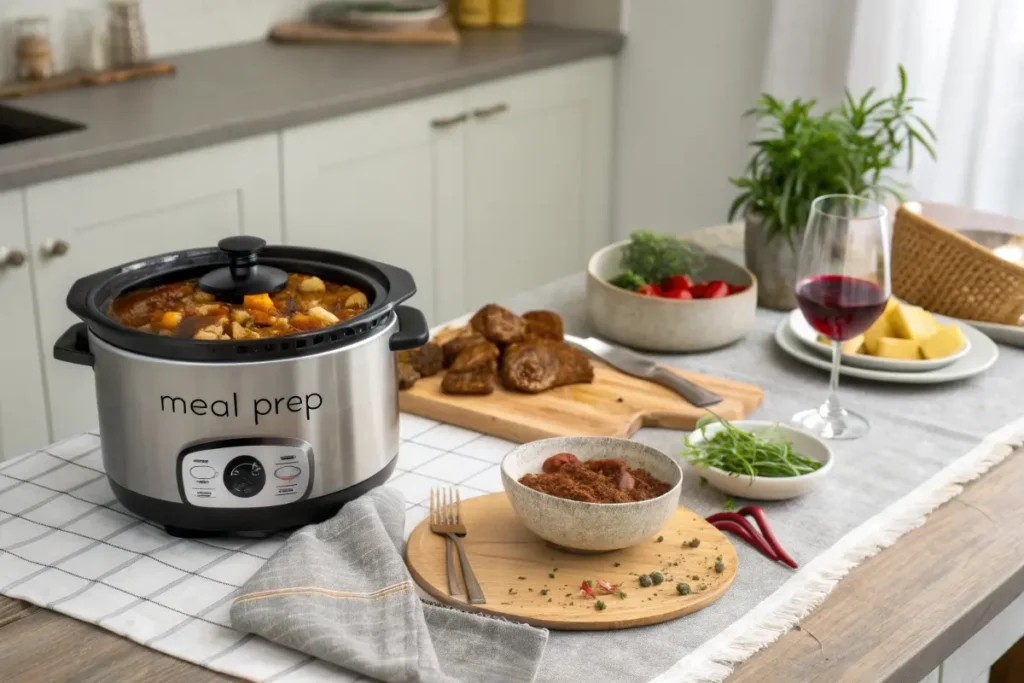
FAQs
Curious about making your own japanese beef curry recipe but have lingering questions? Below are concise answers to common inquiries, helping you achieve flavorful and successful outcomes every time.
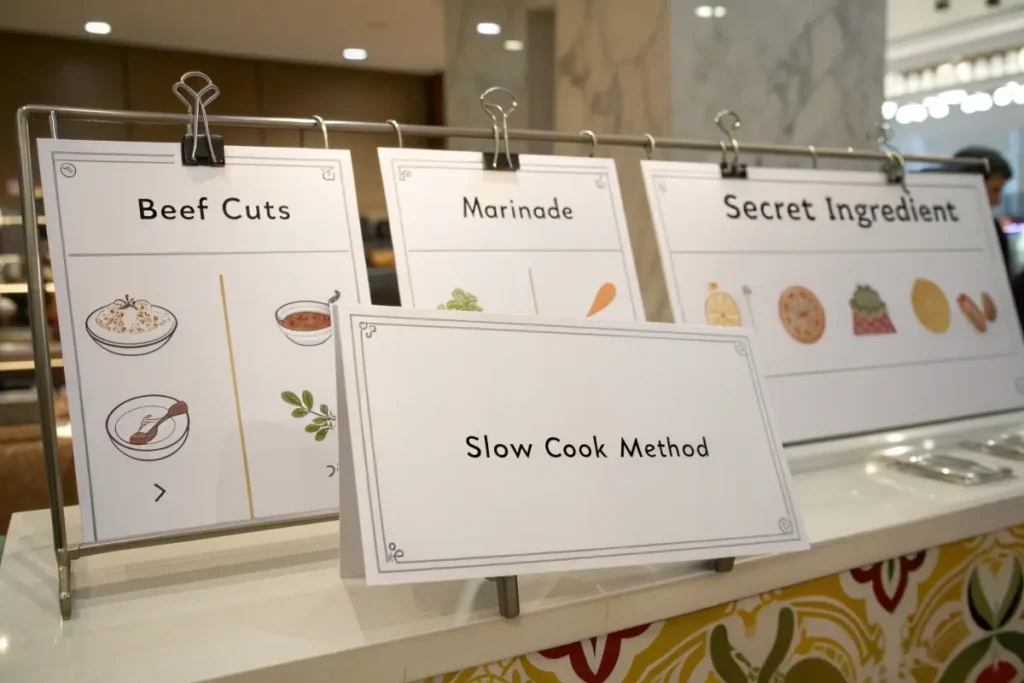
- What kind of beef is best for Japanese curry?
Chuck roast is a popular choice due to its good balance of fat and connective tissue. Cuts like brisket or short ribs also work if you want a richer taste. The goal is a succulent texture achieved by slow simmering. - Do you marinate meat for Japanese curry?
In most cases, you don’t need a long marinade. However, seasoning cubes of beef with salt, pepper, and a dash of soy sauce for about 15 minutes can deepen flavor. This quick prep complements the natural richness of the curry rather than overshadowing it. - What is the secret ingredient for curry?
Commonly, grated apple, honey, or dark chocolate can be added to lend a subtle sweetness and complexity. Adjust quantities based on your preference for sweetness or depth. Some chefs even add a splash of coffee for mild bitterness.
– What makes Japanese curry different?
- Japanese curry focuses on a thick, stew-like sauce that is mildly sweet and savory rather than aggressively spicy. It often involves a roux, which gives it a smooth consistency. Ingredients like carrots, potatoes, and onions are staples, making the dish hearty and accessible.
- How can I make a slow cook Japanese curry?
Brown the beef and aromatics first, then transfer them to a slow cooker with potatoes, carrots, stock, and curry roux. Cook on low for 6-8 hours. Stir occasionally for even distribution and add sweeteners or final seasonings near the end. - Is store-bought curry roux necessary?
Not necessarily. While it offers convenience, homemade curry roux or a blend of curry powder with flour and butter works well. Store-bought blocks come in various spice levels, so choose one that suits your taste. - Can I adapt this for dietary restrictions?
Absolutely. Gluten-free curry roux alternatives or homemade versions can help with wheat sensitivities. Opt for leaner cuts of beef or reduce the roux if you’re monitoring fat intake. For other dietary preferences, consider browsing our Japanese Vegan Recipes for plant-based options.
Bring Japanese comfort food to your kitchen: With just a few key items, you can enjoy restaurant-quality beef curry at home:
- Mochi & Curry Combo Kit – fun way to explore Japanese flavors
- Japanese Soufflé Pancake Mold – perfect dessert pairing with curry
- Assorted Wagashi Gift Box – sweet treat after a hearty curry
Conclusion
Making a japanese beef curry recipe at home brings together the best of hearty stews and comforting Asian flavors. From carefully selecting well-marbled beef cuts to layering sweet and savory nuances, each step is designed to create a velvety sauce that clings to each morsel. The resulting dish can be served with steamed rice or even bread, catering to many types of palates.
If you’re new to Japanese cooking, remember that beef curry and rice is flexible: you can adjust spice levels, add sweeteners like grated apple or honey, and even incorporate extra vegetables or mushrooms for more variety. For busy cooks, a japanese beef curry slow cooker approach offers the same depth of flavor with less hands-on time. Over hours of gentle heat, the beef becomes meltingly tender, and the curry sauce develops a richness few quick meals can match.
As you hone your technique, explore further by pairing your curry with pickled sides or testing out different garnishes. Or, if you’re on the hunt for another satisfying recipe, check out our Japanese Beef Short Ribs Recipe for a similarly succulent experience. Above all, enjoy the process. By blending high-quality ingredients with mindful cooking methods, you’ll capture the essence of Japanese curry—comforting, unpretentious, and utterly delicious.
